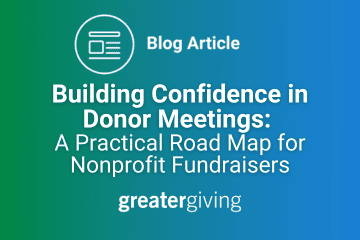
Donor meetings are some of the most important and impactful pieces of your organization’s fundraising strategy, but they can sometimes feel intimidating, especially for new fundraisers, board members, or volunteers. Whether you’re planning your first in-person visit or refining your approach for major gifts, having a clear structure and the right tools can make all the difference.
At Andrews Consulting, we believe that confidence doesn’t come from having all the answers: it comes from preparation and authentic connection. In this post, we’ll walk through key strategies to help you secure donor meetings and show up with clarity and confidence.
Before the Meeting: Prepare with Purpose
A successful donor meeting begins well before you sit down at the table. Here are the key steps to ensure you’re ready:
Confirm the Details
- Send a calendar invite with the meeting location, time, and purpose.
- Double-check directions, parking info, and accessibility.
- Send a confirmation email or text 1–2 days ahead.
Know Your Donor
- Research past giving history, capacity, connections, and involvement.
- Identify what matters to them (past event attendance, program interest, etc.).
- Bring a team member if possible! Having two people at the meeting shows investment and helps build rapport.
Clarify Your Goals
- Are you thanking, informing, cultivating, or asking?
- If you plan to make an ask, define the project, funding need, and giving level.
- Know your role and who will be telling a story and sharing impact, and who will be making the invitation for support.
Dress, Tools, and Talking Points
Dress appropriately for the setting and donor style—professional but approachable. Prepare materials that may include:
- Impact report or recent newsletter
- Specific program/project info
- Event invitation
- Thank you note or personal message
- Business cards
Review key talking points, recent updates, and donor-relevant information. Tailor your language and examples to what matters most to them.
The Donor Meetings: Connection Comes First
Start by expressing gratitude. Match the donor’s tone and pace. If you’re meeting at a coffee shop or restaurant, defer to their preferences. Building authentic connections sets the stage for deeper conversation.
Use open-ended questions to encourage storytelling and reflection. Some of our favorites:
- Why did you first choose to give to our organization?
- What interests you most about our mission?
- What do you hope your giving will accomplish?
- What legacy would you like to leave?
These types of questions open the door to deeper understanding and build long-term trust.
Making the Ask
When it’s time to talk about support, try using the “ask-to-ask” technique:
“Would it be okay to talk about your support for [organization/project] now?”
This respectful segue allows the donor to prepare for the shift in conversation. Use your materials to guide the discussion and be specific:
“Would you consider a $10,000 gift to support our new youth center initiative?”
Then, pause and listen. Resist the urge to fill silence! This is where essential information surfaces.
After the Meeting: Follow-Up is Everything
No matter the donor’s response (yes, no[t right now], or maybe), your follow-up will define the experience. Within 90 days of the donor meeting, aim to thank and steward each donor in at least 3-5 different ways. Be sure to log the meeting in your donor database and add calendar reminders for follow-up. Consistency builds trust.
Final Thoughts
Donor meetings are about relationships, not revenue. When you prepare with intention and lead with curiosity, you turn these conversations into powerful moments of authentic connection, alignment, and generosity.
Learn how to Grow Your Event Income with Sarah Andrews in this recorded Webinar.
